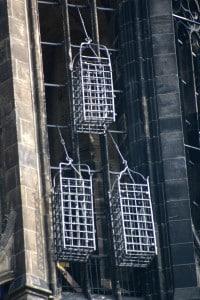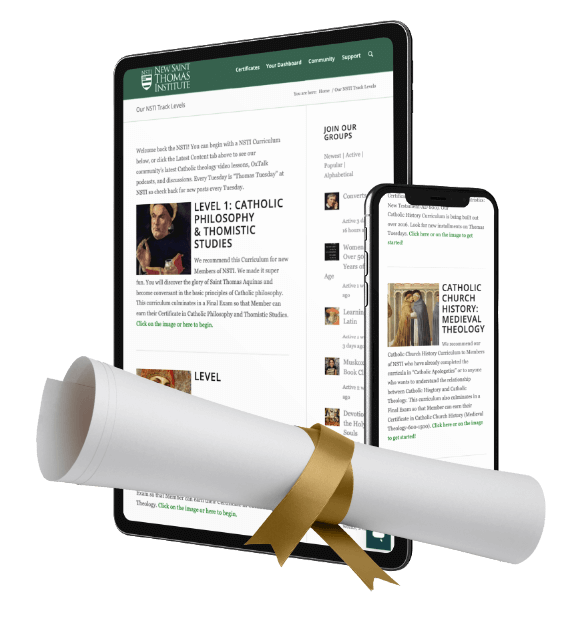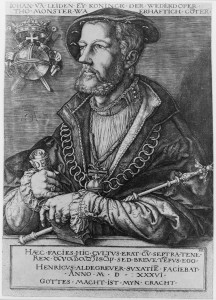Heretical Münster Rebellion Timeline of Events
I recently listened to Dan Carlin’s fantastic Hard Core History episode “Prophets of Doom” about the Protestant debacle at Münster, Germany in AD 1534-35. I would encourage you all to listen to it by clicking here.
The short story is that a bunch of Lutherans took over Munster, Germany but they were not content with Luther’s so-called conservatism. They wanted an even more radical form of Christianity that rejected infant baptism, the Eucharist, and included “biblical” teachings such as communism and polygamy (!).
I was so interested in the history of this story, I put together this time line of events. If you do listen to Dan Carlin’s podcast, this will serve as a handy resource:
5 Key Players in the Münster Rebellion
The “Two Bernard’s”
- Bernhard Rothmann: The anti-Catholic pamphleteer.
- Bernhard Knipperdolling: The first Anabaptist Mayor of Münster. Under “King” Jan, he became the “Steigbügelhalter” (literally “stirrup-holder”) of Jan of Leiden.
The “Two Jan’s”
- Jan Matthys of Haarlem: The Original Prophet of Munster. He was a follower of Melchior Hoffman.
- Jan of Leiden: The Second Prophet and “King” of Munster. He was a follower of Jan Matthys.
Anabaptist Hysteria Begins after Martin Luther
- 1524-1525 German Peasants’ War. German peasants adopt a radical political interpretation of Martin Luther’s anti-authoritarian teachings. They reject not only the Church (Luther) but now also the State and civil authorities as “anti-Christian.” Luther condemned their civil unrest and these peasants were cut down by mutual agreement between Catholics and Lutherans.
- Radical Protestants no longer feel loyal to Luther and explore new approaches to their (manifold) interpretations of Sacred Scripture.
- 1527 The first Anabaptist (re-baptism sect) synod formulates the Schleitheim Confession in Schleitheim (Switzerland) condemning the Catholic Church, infant baptism, oaths, celibacy, and transubstantiation.
- April 1530 Melchior Hoffman is re-baptized and then spreads the idea of adult re-baptism in Strasbourg as well as his eschatological form of Anabaptist doctrines.
- 1532 Melchior Hoffman, assuming the office of prophet, declares Christ will return to Strasbourg in 1533 to establish the one thousand year reign of Christ. (He was wrong.)
Meanwhile Munster Becomes Officially Lutheran (Feb 1533-Jan 1534)
- 14 February 1533. Münster officially becomes a Lutheran city. The city’s Catholic Bishop Franz von Waldeck was sympathetic the writings and reform of Martin Luther – this celibate bishop already had a “wife” and children.
- Summer 1533. Bernhard Rothmann, an anti-Catholic Lutheran of Munster is convinced by Melchior Hoffman to withdraw from Lutheranism and embrace the heretical belief that infant baptism is invalid and that adults must be re-baptized. Rothmann produces theological treatises against the Catholic Church and infant baptism – he’s Anabaptist.
- Rothman’s friend and wealthy wool merchant Bernhard Knipperdolling through the aid of a printing press began to publish Rothmann’s anti-Catholic tracts for Munster and the rest of northern Germany.
- Rothmann’s tracts convince most of Munster to move beyond Lutheranism and instead embrace the radical Anabaptist theology of Melchior Hoffman.
- Bernard Rothmann and his allies take over the political offices of Munster, and Bernhard Knipperdolling (the second Bernard in this story) becomes the Mayor of Munster after deposing the Lutheran magistrates, who, until then, had seen him as an ally in their own distrust of the Catholic Church.
- The two Bernards now believe that Lutheranism doesn’t go far enough.
Jan Matthys Becomes Anabaptist Prophet of Münster (Jan 1534-April 1534)
- January 5, 1534, Anabaptist prophet Jan Matthys identified Münster as the “New Jerusalem” and a number of his disciples entered the city and introduced adult re-baptism. Rothmann accepted “re-baptism” that day, and over 1,000 adults were soon re-baptised.
- February 10, 1534, Bernard Knipperdolling, Mayor of Munster, joined the Anabaptist movement to overthrow the town council and bishop. Anabaptist prophets Jan Matthys and Jan of Leiden Bockelson, one of Matthys’ twelve disciples, begins to shepherd the people of Munster.
- The Catholic Prince-Bishop of Munster Franz von Waldeck, a Catholic cleric of Lutheran sympathies besieges he city from without.
- April 4, 1534 (Easter Sunday) Jan Matthys, who had prophesied God’s deliverance on Easter day of 1534, made a sally with only thirty followers, believing that he would single-handedly defeat the Prince-Bishop’s armies. To the shock of Munster’s inhabitants, Matthys was killed, his head severed and placed on a pole for all in the city to see, and his genitals nailed to the city gate.
Jan of Leiden Becomes King of Munster (April 1534-June 1535)
- Jan of Leiden was subsequently recognized as Matthys’ religious and political successor, justifying his authority and actions by the receipt of visions from heaven. Jan of Leiden married the beautiful widow of Matthys to signify the continuity of prophetic office.
- Jan of Leiden proclaimed himself to be the successor of David and assumes royal regalia, honors and absolute power in the new “Zion” and “New Jerusalem” of Munster.
- Jan of Leiden legalized polygamy, and himself took sixteen wives. (Jan is said to have beheaded one woman in the marketplace for refusing to marry him; this act might have been falsely attributed to him after his death.)
- Community of goods (religious communism) was also established.
The Bishop’s Siege of Munster (June 1535)
- June 24–25, 1535, the Bishop, with the aid of the deserter Henry Gresbeck, retook Münster. “King” Jan of Leiden and several other prominent Anabaptist leaders were captured and imprisoned. The residents of Münster were starving as a result of the year-long siege. The people are put to the sword.
- January 22, 1536 Jan of Leiden,
 Bernhard Knipperdolling and one more prominent follower, Bernhard Krechting, were tortured and executed in the marketplace of Münster. Their bodies were exhibited in cages, which hung from the steeple of St. Lambert’s Church. The bones were removed later, but the cages hang there still.
Bernhard Knipperdolling and one more prominent follower, Bernhard Krechting, were tortured and executed in the marketplace of Münster. Their bodies were exhibited in cages, which hung from the steeple of St. Lambert’s Church. The bones were removed later, but the cages hang there still. - The body of Bernhard Rothmann, the anti-Catholic pamphleteer who introduced Melchior Hoffman, Jan Matthys, and Jan of Leiden to Munster, was never found.
- 1543. Melchior Hoffman, the Anabaptist preacher who started it all, dies.
So there it is. It’s a crazy, but true, story of what can happen when Christians reject authority and the magisterial teachings of the Church!
[reminder]
What to Watch Next
SHOP THE TAYLOR MARSHALL STORE
Dive Deeper

GET CONFIDENT IN YOUR FAITH
Explore the fascinating world of Catholic teachings with Dr. Marshall. Together you’ll unpack the brilliant answers the Church gives to tough questions about the Faith. The best part: you go at your own pace. Start this exciting journey today.


 >
>



